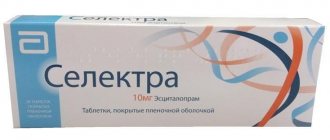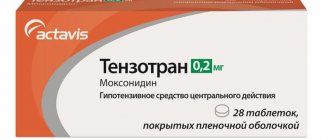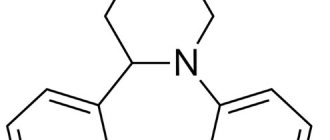In modern medicine, a lot of attention is paid to drugs that help older people fight the gradual degradation of the body’s motor system (tremor, muscle rigidity, hypokinesia, inability to maintain balance) and chronic neurological manifestations.
Levopoda is used as a drug that helps treat and maintain the body in such disorders.
In nature, its main component can be found in plant and animal organisms.
This drug contains levodopa (international name levodopa). In addition, depending on the manufacturer or what the main element is combined with, the medicine may contain the following active substances:
- Benserazide, international name benserazide;
- Carbidopa;
- Entacapone;
- Pergolide;
- Ropinirole;
- Baclofen;
- Salbutamol (Salbutamol);
- Biperiden;
- Trihexyphenidyl;
- Levothyroxine sodium;
- Spiramycin;
- Flupentixol;
- Zuclopenthixol;
- Selegiline.
The medicine looks like a white crystalline powder. Please note that levodopa is not soluble in alcohol and is poorly soluble in water.
This substance is used by nerve cells to produce and restore the balance of dopamine in the blood.
This element practically does not penetrate the brain and therefore it is combined with carbidopa in order to enhance the effect and penetration of the substance from the blood vessels into the human brain.
Among the producers of Levodlpa are such countries and organizations as: Dopaflex (Dopaflex) Egis, Hungarian Republic; Caldopa (Caldopa) Cadila, India; Levodopa Dabur, India, Remedica (Cyprus), TEVA Pharmaceutical Industries (Israel), TEVA Pharmaceutical Works Private (Hungary), F.Hoffmann-La Roche (Switzerland), Roche (Italy),
Among the manufacturers of similar drugs, the following manufacturers of combination drugs can also be identified :
- LEK dd (Slovenia);
- Sandoz (Switzerland);
- Torrent Pharmaceuticals (India);
- Orion corporation orion pharma (Finland).
Do you have an inexplicable feeling of anxiety and fear that develops into panic? This is a vegetative crisis - symptoms and treatment of the disease. In what cases does atrophy of the cerebral cortex occur and are there effective methods to prevent the process?
Pharmacodynamics and pharmacokinetics
The antiparkinsonian combination drug is aimed at eliminating hypokinesia, rigidity, tremor, dysphagia and drooling . Inside the body, levodopa is converted into dopamine , which occurs precisely in the central nervous system, replenishing the lack of this substance. Dopamine , which is formed in peripheral tissues, does not contribute to the manifestation of the antiparkinsonian effect of levodopa, since it does not penetrate the central nervous system. Therefore, it is responsible for the main side effects of levodopa.
The peripheral dopa decarboxylase inhibitor, carbidopa, is able to reduce the production of dopamine in peripheral tissues, increasing the amount of levodopa that enters the central nervous system. The optimal ratio of levodopa to carbidopa is 10/1 or 4/1. The drug begins to act within 24 hours from the start of treatment. The full effect is achieved after 7 days.
Once in the body, levodopa is quickly absorbed into the gastrointestinal tract. In this case, the absorption of the substance is 20-30%, the therapeutic effect is felt after 2-3 hours. Concomitant consumption of food affects the absorption of the drug, as does the intake of certain foods. As a result of metabolism several metabolites , for example: dopamine, norepinephrine and epinephrine . The substance is excreted through the kidneys and intestines - some in metabolites, the rest unchanged.
Mechanism of action
According to its parameters, levodopa is a drug prescribed for low levels of dopamine in the brain.
Only a small amount of the active substance (about 3%) enters the brain, so the effect of the drug increases gradually.
Positive results of the drug can be noticed within a week or two, and the maximum effect can be achieved within 25-30 days.
Indications for use
Carbidopa/Levodopa is prescribed for:
- Parkinson's disease;
- parkinsonism syndrome, except those caused by taking antipsychotic drugs;
- postencephalitis syndrome , which occurs during cerebrovascular diseases or toxic intoxication.
Contraindications for use
The drug is not prescribed for:
- hypersensitivity;
- angle-closure glaucoma;
- melanoma or suspicion of its development;
- skin diseases of unknown etiology;
- simultaneous use of non-selective MAO inhibitors;
- under 18 years of age.
Caution should be observed when treating patients with myocardial infarction, heart rhythm disturbances , severe heart and lung diseases, epileptic and convulsive seizures, erosive and ulcerative lesions of the gastrointestinal tract , diabetes mellitus and other decompensated endocrine diseases , open-angle glaucoma , severe hepatic or renal failure , lactation and pregnancy .
Side effects
When taking Carbidopa and Levodopa, various side effects may occur, affecting the functioning of almost all body systems. Therefore, the cardiovascular system can react by developing: arrhythmia, rapid heartbeat, orthostatic reactions - pressure disturbances, fainting, and so on.
Abnormalities in the digestive system can manifest themselves as: vomiting, anorexia, diarrhea, constipation, dyspepsia, dry mouth, changes in taste, bleeding from the gastrointestinal tract and other symptoms.
It is also possible that side effects may develop, affecting the activity of the hematopoietic organs, nervous, respiratory and urinary systems.
In addition, allergic reactions , undesirable manifestations on the skin, changes in laboratory parameters and other side effects often occur.
Carbidopa / Levodopa, instructions for use (Method and dosage)
The instructions for the drug indicate that the tablets should be taken orally in their entirety, with liquid, at the same time or after meals. It has been established that when absorbed, levodopa can compete with aromatic amino acids, so during the treatment period it is necessary to reduce protein intake.
The average daily dosage of carbidopa required to suppress the peripheral conversion of levodopa is approximately 70-100 mg. If the dose is higher than 200 mg, then this only enhances the therapeutic effect. In this case, the daily dosage of levodopa should not exceed 2000 mg.
Treatment begins with a dose of half a tablet, which is taken 2 times daily. The dosage is gradually increased.
Usually the daily dose for replacement treatment does not exceed 3 tablets, that is, 1 piece for 3 times a day. This dosage is prescribed for the treatment of severe cases of parkinsonism. With monotherapy, the daily dose may be increased as prescribed by a specialist. However, taking 6 tablets per day requires caution and supervision by a doctor.
Pharmacokinetics
When taken orally, it is quickly absorbed from the gastrointestinal tract. Absorption depends on the rate of gastric emptying and the pH in the stomach. The presence of food in the stomach slows down absorption. Some dietary amino acids may compete with levodopa for absorption from the intestine and transport across the BBB. Cmax in blood plasma is achieved 1-2 hours after oral administration.
Only 1-3% of the active substance penetrates the brain, the rest is metabolized extracerebrally, mainly by decarboxylation to form dopamine, which does not penetrate the BBB.
About 75% is excreted in the urine in the form of metabolites within 8 hours.
Interaction
The simultaneous use of levodopa and beta-agonists , ditilin and drugs intended for inhalation anesthesia increases the likelihood of disturbances in heart rhythm. Tricyclic antidepressants may reduce the bioavailability of levodopa.
The combination of levodopa and Diazepam, Phenytoin, Clonidine , M-cholinergic blockers, antipsychotic drugs, Diphenylbutylpiperidine, Thioxanthene, Clozapine, Phenothiazine, Pyridoxine, Papaverine, Reserpine often reduces its antiparkinsonian effect. While lithium preparations increase the likelihood of dyskinesias and hallucinations , and methyldopa increases side effects.
Combinations of levodopa and MAO inhibitors - except MAO-B inhibitors - can lead to circulatory disorders, so the interval between doses of these drugs should be at least 2 weeks. The reason for this lies in the accumulation of norepinephrine and dopamine under the influence of levodopa, the inactivation of which is inhibited by MAO inhibitors, increasing the likelihood of developing agitation, tachycardia, high blood pressure, dizziness and facial flushing.
A pronounced decrease in blood pressure is observed with the combination of levodopa and tubocurarine.
Metoclopramide increases the bioavailability of levodopa by promoting gastric emptying, but this may have an adverse effect on the course of the disease due to antagonism with major dopamine receptors and so on.
Levodopa and Parkinson's disease: common misconceptions
Clinical trial results can often lead practitioners down the wrong path. Incorrect interpretation of studies and the lack of their pathophysiological context form myths about drug therapy, which, moreover, comply with the principles of evidence-based medicine. This article provides an overview of three such myths associated with the side effects of taking levodopa in Parkinson's disease.
Introduction
Parkinson's disease is one of the common neurological disorders, a chronic progressive disease that develops due to the degeneration of dopaminergic neurons in the substantia nigra of the brain. The cause of early disability in patients with Parkinson's disease is a combination of symptoms such as motor disorders (hypokinesia, muscle rigidity, tremor), autonomic and mental manifestations. Moreover, the latter usually occur at advanced stages of the disease and are associated with the involvement of the body’s non-dopaminergic regulatory systems in the pathological process. Clinical manifestations of the disease are associated with a neurotoxic effect: with the progression of the degenerative process, the protein alpha-synuclein accumulates in the cells of nerve structures, which has a toxic effect and causes dysfunction, first of the peripheral and then of the central nervous systems [1].
In addition to Parkinson's disease itself, it is customary to distinguish the concept of parkinsonism syndrome, which occurs in other neurodegenerative conditions; Parkinson's disease can thus be considered an idiopathic variant of the syndrome. Variants of parkinsonism include, for example, progressive supranuclear palsy. Parkinsonism syndrome has some clinical differences from Parkinson's disease, such as rapid progression of the disease, early onset of postural instability, pyramidal and cerebellar signs, early development of dysarthria, dysphagia and contractures.
One of the most effective drugs in the treatment of Parkinson's disease, according to the ELLDOPA study, is levodopa, or 3-hydroxy-L-tyrosine [2]. Levodopa is a precursor of dopamine, replacing its deficiency in brain structures. Other antiparkinsonian drugs (dopamine receptor agonists, monoamine oxidase type B inhibitors, catechol-O-methyltransferase inhibitors) have significantly less effectiveness, but are sometimes prescribed instead of levodopa, as it turns out, often due to fear of developing side effects. The most frightening of these effects are two conditions: drug-induced dyskinesia and motor fluctuations.
Dyskinesia is involuntary movements in various muscle groups - a motor disorder that, at first glance, seems extremely undesirable in patients with Parkinson's disease. Motor fluctuations are fluctuations in the effect of levodopa that occur when the next dose of the drug wears off. The occurrence of motor fluctuations is associated with the short half-life of levodopa, which forms stimulation of dopamine receptors that is uneven in intensity. With time of taking levodopa, such fluctuations become quite sharp and are manifested by the unpredictable appearance and disappearance of motor symptoms of the disease, which are called “off” and “on” periods, respectively.
The side effects described seem really scary, but it turns out that there are a lot of misconceptions around them, often preventing patients with Parkinson's disease from receiving effective and reasonable treatment. The authors of the material selected three common myths about taking levodopa, each of which was debunked [3].
Myth 1: Taking levodopa causes dyskinesia.
It is easiest to take the wrong path in this case, because dyskinesia is often found in patients taking levodopa. Studies have noted that the development and severity of dyskinesia positively correlates with the dose of levodopa taken, but the latter is in this case an important and not a key factor in the development of motor disorders. A combination of three factors plays a role in the formation of dyskinesia: Parkinson’s disease itself, levodopa intake and its delivery mechanism. The first condition is supported by the fact that levodopa does not cause dyskinesia in parkinsonism caused by other neurodegenerative conditions. In the context of the method of delivery of the active substance, it is known that the combination of levodopa-carbidopa (in Russia - the drug Duodopa), which enters the body through intestinal infusion in the form of an intestinal gel, does not cause drug-induced dyskinesia and reduces the severity of existing hyperkinesis. This is achieved by providing constant, moderate stimulation of dopamine receptors. Thus, we can conclude that the dyskinesia that occurs when taking levodopa is more likely related to the method of drug delivery than to its direct effect. A more precise definition of this phenomenon is levodopa-associated rather than drug-induced dyskinesia [4].
Myth 2: dopamine receptor agonists delay the development of dyskinesia compared to levodopa
In the treatment of Parkinson's disease, there is the concept of “peak dose” dyskinesia. This is a manifestation of super-strong stimulation of dopamine receptors at the height of the action of a single dose of levodopa, in which hypokinesis, characteristic of parkinsonism, is replaced by hyperkinesis. Peak dose dyskinesia (as well as other patterns of drug-induced dyskinesia) demonstrates the effectiveness of the treatment, but is an undesirable effect. That is why clinicians often motivate the non-prescription of levodopa by the desire to “delay” the onset of dyskinesias. Such beliefs are built around another myth about levodopa.
As already mentioned, other antiparkinsonian drugs, including dopamine receptor agonists, often do not achieve the effectiveness of levodopa even at the maximum tolerated doses. Related to this is the fact that such drugs do not “postpone” the development of dyskinesia, but rather are unable to cause it. Since the development of dyskinesia begins with the onset of Parkinson's disease, and not with the start of taking levodopa, deliberately delaying the administration of the latter has no practical significance. Dyskinesia in patients with Parkinson's disease can still occur, but in the case of taking levodopa, drug dyskinesia will indicate the effectiveness of the drug, whereas in the absence of levodopa, the development of the disease can lead to much more severe consequences.
A large study comparing patients with Parkinson's disease taking and not taking levodopa confirmed the great importance of this drug in improving quality of life, even despite the occurrence of dyskinesia in patients. According to this study, most patients eventually switch to levodopa or add it to existing therapy to improve symptom control. Only 2% of patients taking levodopa discontinue treatment due to side effects; in the group of patients taking dopamine receptor agonists and MAO type B inhibitors, they were 28% and 23%, respectively. It is becoming clear that despite the reduction in the incidence of drug-induced dyskinesia, antiparkinsonian drugs without levodopa can cause other, non-motor disorders, which, coupled with the insufficient effectiveness of these drugs, become the basis for changing therapy to levodopa [5].
Myth 3: motor fluctuations and levodopa use
This myth is based on before-and-after studies of levodopa, which demonstrate dose-dependent changes in motor function and the number of off periods in patients with different treatment options. In the mechanism of occurrence of motor fluctuations, it is important to understand the following: the presence of a period of “off”, that is, the appearance of motor symptoms of Parkinson’s disease, indicates the effectiveness of therapy, that is, the presence of a previous episode of “on” with optimal control of motor functions. Patients taking low doses of levodopa who do not have off periods are likely to have no on periods, so the dose they are taking may not be effective. That is why one of the clinical tactics “start taking levodopa as late as possible and in as low doses as possible” turns out to be completely wrong. Instead of levodopa in this case, other antiparkinsonian drugs are often prescribed; however, the ineffectiveness of such a technique has already been discussed above. The withdrawal of levodopa is essentially unacceptable for a disease that requires replacement therapy - just as it would be incorrect not to prescribe insulin for type 1 diabetes. Without the correct amount of levodopa, patients live with greater disability and poorer quality of life [3].
Thus, it is important to understand that therapy for Parkinson’s disease with levodopa, despite the existing picture of side effects, is irreplaceable in its effectiveness. The associated conditions that arise demonstrate the pathophysiological effects of the drug and in the long term are not as disabling and reduce the quality of life as the non-motor consequences of the progression of the pathology. Doctors and patients must be properly informed about the possible consequences of taking levodopa, because only with reasonable, sufficient therapy will full therapeutic control of Parkinson's disease be possible.
Sources:
- Alpha-synuclein in Parkinson's disease. / Leonidas Stefanis. // Cold Spring Harb Perspect Med. - 2012. - Vol. 2, No. 2.
- Symptomatic pharmacological therapy in Parkinson's disease. / The National Collaborating Center for Chronic Conditions. - London: Royal College of Physicians - 2006. - p. 59–100.
- Common myths in the use of Levodopa in Parkinson disease: when clinical trials misinform clinical practice. / Espay AJ, Lang AE. // Jama Neurol. — 2021. — Vol. 74, no. 6. - p. 633-634.
- Effect of levodopa-carbidopa intestinal gel on dyskinesia in advanced Parkinson's disease patients. / Antonini A, Fung VS, Boyd JT. // Mov Disord. — 2021. — Vol. 31, No. 4. — p. 530-537.
- Don't delay, start today: delaying levodopa does not delay motor complications. / Fox SH, Lang AE. //Brain. — 2014. — Vol. 137. - p. 2628-2630.
special instructions
Discontinuation of levodopa should be done gradually, since abrupt withdrawal leads to the development of a symptom complex that resembles neuroleptic malignant syndrome, with muscle rigidity, increased body temperature, mental disturbances and increased activity in the blood serum. Therefore, when reducing the dosage, monitoring the patient's condition is required.
Carbidopa/Levodopa is not prescribed to treat extrapyramidal reactions caused by other drugs.
In addition, during treatment with this drug, monitoring of the patient's mental state and his peripheral blood . However, protein-rich foods can interfere with absorption. Patients with glaucoma require regular monitoring of intraocular pressure.
If treatment with Carbidopa/Levodopa is carried out for a long time, it is important to periodically monitor the functioning of the kidneys, liver, hematopoiesis and cardiovascular system.
Overdose and additional instructions
In case of overdose, the patient’s heart rhythm is disturbed, an involuntary motor reaction appears, etc. And, unfortunately, treatment is only symptomatic, since the drugs administered are not very effective.
The patient requires an inpatient stay in the hospital and constant monitoring of the cardiovascular system, since, if necessary, he will need urgent therapy.
What happens during an overdose
With more severe poisoning, in addition to the symptoms listed above, nausea, vomiting, confusion and insomnia may occur. It often takes quite a long time (since the drug is absorbed by the cells of the body for a long time) before symptoms appear.
Despite all this, treatment remains symptomatic.
Side effect
Side effects are quite serious and affect almost the entire body to one degree or another. Among the risk groups are the following organs and systems of the human body:
- Hematopoietic system. Consequences such as anemia, transient leukopenia, thrombocytopenia may occur.
- Nervous system - headache, dizziness, seizures and other movement disorders
- Mental disorders; very rarely - hallucinations, temporary disorientation.
- Cardiovascular system - arrhythmias, hypotension, increased blood pressure.
- Digestive system. Manifestations in the form of nausea, vomiting and even diarrhea. Sometimes there was a loss or change in taste, dryness of the oral mucosa, as well as gastrointestinal bleeding.
- Skin and subcutaneous tissues - itching or rash.
According to the results of laboratory indicators, there is an increase in the activity of “liver” cells, which leads to serious consequences.
In addition, febrile fever and excessive sweating may occur.
special instructions
Those taking this medicine must be careful, as an inhibited psychomotor reaction occurs. At the same time, sudden changes in medications or complete cessation may lead to new, more effective treatment options.
In the case of current realities, the patient may need long-term therapy.
During the period of therapy, it is necessary to carry out blood tests relatively often, check the functions of the liver and kidneys.
Drug and alcohol
In this particular case, alcohol only slows down the process of treatment and absorption of the drug in the blood.
If kidney and liver functions are impaired
If liver and kidney function are impaired according to the instructions of the drug to a mild to moderate degree, it is necessary to continue taking the drug without changes in dosage. But in case of severe violations of these functions, taking this drug is prohibited.
Interaction with other drugs
The interaction of the drug with antidepressants is quite dangerous.
In this case, there is a high probability of the following symptoms: excitability, increased blood pressure, tachycardia, facial flushing and dizziness. In addition, the following combinations are dangerous:
- With antihypertensive drugs;
- With anesthetics. Concurrent use of anesthetics may cause arrhythmia;
- With anticholinergics – help relieve tremor;
- With other medications, as directed by your doctor.
During pregnancy and lactation
This drug is contraindicated for both women of childbearing age and pregnant and young mothers. Defects in the development of internal organs and skeleton were identified in animal experiments.
Reception by children
The drug is not safe for children and is not prescribed for children under 25 years of age.
Analogs
Level 4 ATX code matches:
Madopar
Levodopa / Benserazid-Teva
Sindopa
Tidomet Forte
Sinemet
Tremonorm
On whom
The main analogues are represented by the following drugs: Dopar 275, Duellin, Zimox, Izikom, Izikommite, Nakom, Sindopa, Sinemet, Tidomet, Tremonorm and so on.
Reviews of Carbidopa / Levodopa
Treatment of any disease must be carried out as prescribed by a doctor, especially if we are talking about Parkinson's disease . It should be noted that taking this drug on your own, it is impossible to achieve a positive effect. Therefore, reviews of Carbidopa / Levodopa left by people who take the drug on their own, even for a long time, report that there are no noticeable improvements.
When Carbidopa/Levodopa is taken according to a regimen developed by a doctor who closely monitors the process and adjusts therapeutic doses, treatment is more successful. At the same time, reviews from patients who are undergoing treatment under the supervision of a specialist indicate that this drug is a fairly effective medicine.
Reviews from patients and doctors about the drug Levodopa
Let's study reviews about the drug Levodopa. Many people who have taken the drug speak well of it, but the side effects still make themselves felt. It is the presence of a side effect that divides opinions about the drug 50/50.
What do the doctor's say
Doctor Sergey Lirtugin
It has been established that the therapeutic effect is achieved in 50-60% of patients. For the rest, the effect is mild; the dose of the drug cannot be increased due to side effects.
Patient reviews
Peter, 74 years old
In general, in my opinion, everything depends on the perception of this drug by the body. For some, it relieves the symptoms of Parkinson's disease for a long time, but for others it does not - the effect of the drug does not last long, sometimes it enhances involuntary motor reactions.
Vasily, 68 years old
The drug hit the kidneys hard and caused a severe complication of failure. I had to give it up, which is a pity, because the effect was excellent.
Advice from patients
With prolonged use, as well as deterioration of health, you can reduce the dose of the drug taken.
Also, some patients note the effect as an antidepressant, but the drug can lead to addiction.
The side effects of the drug prevent us from giving it an excellent rating, however, in cases where they are absent, the drug copes 100%.









